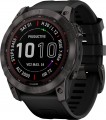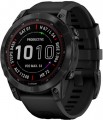Size
The size of the display installed in the gadget; for round screens, respectively, the diameter is indicated.
A larger screen, on the one hand, is more convenient to use, on the other hand, it significantly affects the dimensions of the entire device, which is especially critical for wearable gadgets. Therefore, manufacturers choose the display size in accordance with the purpose and functionality of each specific model — so that there is enough space on the screen and the device itself is not too bulky.
It is also worth mentioning that screens with a similar size may have different aspect ratios. For example, traditional smartwatches are usually equipped with square or round panels, while in fitness trackers, screens are often made elongated in height.
Screen resolution
Screen size in dots (pixels) horizontally and vertically. In general, this is one of the indicators that determine the image quality: the higher the resolution, the clearer and smoother the picture on the screen (with the same size), the less noticeable are the individual dots. On the other hand, an increase in the number of pixels affects the cost of displays, their power consumption and requirements for a hardware platform (more powerful hardware is required, which itself will cost more). In addition, the specifics of using smartwatches is such that there is simply no need to install high-resolution screens in them. Therefore, modern wrist accessories use displays with a relatively low resolution: for example, 320x320 with a size of about 1.6" is considered quite sufficient even for premium watches.
Extra features
—
Built-in player. The presence of a player in the smartwatch allows you to use the gadget to listen to music. There is no need to connect to the phone for this. The songs will play directly from the watch. Therefore, these devices must necessarily have an impressive (as for a watch) amount of storage and be able to connect to headphones (for connection with headphones).
—
Light sensor. A sensor that monitors the brightness of ambient light. One of the most popular ways to use this feature is to auto-adjust the brightness of the display: in bright light, it increases so that the image remains visible, and at dusk it decreases, which reduces eye strain and energy consumption. In addition, other more specific features may be provided — for example, turning on the screen when pulling back the sleeve of clothing.
—
WiFi. A technology originally used to access the Internet via wireless access points, but more recently also used for direct communication between two devices (such a connection has several advantages over traditional Bluetooth). In wearable gadgets, the first option is most often provided, although the second is also found. However, the specific uses of Wi-Fi may be different depending on the device: accessing websites and various Internet services, remote communication with smart home systems, remote control of digital cameras and other electr
...onics, transmission of the GPS- coordinates via Internet (in children's beacons), etc.
— NFC. Wireless communication technology over short distances (up to 10 cm). The methods of its application, including in wearable devices, may be different. One of the more popular options is using contactless payment (see below); however, the presence of such a function does not hurt to verify separately. Another common feature is the simplification of Bluetooth connection with a smartphone or tablet that also has NFC: instead of manual configuration, it is enough to bring one device to another — and they will automatically establish a connection, all that remains is to confirm it. Other ways of interaction may also be possible, for example, launching a “sports” application on a smartphone when bringing a fitness tracker to it. And theoretically, more specific options for using NFC are also allowed — for example, as a travel pass, ID, etc. Actually, in many models of wearable gadgets, the set of these methods is limited only by installed applications.
— Contactless payment. The possibility of using a wearable gadget for contactless payment. This feature is found only in models with NFC (see above); it actually turns the device into an analogue of a credit card with a chip and allows you to pay without taking the card out of your wallet — just bring your hand with the gadget to the terminal reader. This provides not only additional convenience, but also security. So, bringing the watch to the terminal is definitely easier than reaching into your pocket or purse for a credit card — especially if your hands are busy shopping. And instead of a traditional card, from which an attacker can copy basic details such as a number, CVV code and expiration date (for example, by “peeping” them with the built-in camera), a gadget is used that transmits this data in encrypted form and does not display it explicitly anywhere.
To use contactless payment, usually, you need to synchronize your gadget with your smartphone and set up such payment in the Google Pay or Apple Pay system. But to make payments, a smartphone is no longer required — many wearable devices are able to perform this feature completely autonomously (although this possibility still needs to be specified separately).
— Accelerometer. A sensor that determines the direction of gravity, as well as the accelerations acting on the device. This allows you to track two parameters at once: the current position in space and various physical influences (like tapping or shaking). Most often, the accelerometer is responsible for two main features: automatic rotation of the image on the screen, as well as the operation of the pedometer (in fact, the presence of such a sensor is almost guaranteed to mean the presence of a pedometer, see "Possible measurements"). However, there are other ways to use this sensor — for example, rejecting an incoming call when shaking the watch, turning on the screen when tapping on it, etc.
— Gyroscope. A device that allows you to track the turns of the gadget in one direction or another. Typically used in conjunction with an accelerometer. The gyroscope improves the accuracy of positioning in space (which has a positive effect on the quality of the pedometer and other similar functions), and also provides additional options for managing gestures. However, the specific applications of this sensor are highly dependent on the model.
— Camera. The watch/bracelet has its own built-in camera; its location and purpose differs from model to model. In some devices, the lens is located on the front panel, above the screen, and the matter is limited only to video communication and taking selfies, while others allow you to shoot “classic” photos or videos. At the same time, it is worth noting that anyway, the specs of such cameras are usually very limited — for example, the resolution rarely exceeds 2 megapixels, and autofocus is provided only in the most advanced models.
— Flashlight. Built-in flashlight — usually in the form of a small LED mounted directly in the case. Usually, it has a relatively modest brightness, but it can still be useful for simple tasks like lighting your path at night, lighting in a garage or basement, etc.Operating time (normal mode)
The time that the gadget can work on one battery charge (or the supplied battery) in normal use.
Normal mode, as a rule, means working with a relatively low load. At this time, the display can display some data, and basic functions can also work (counting steps, periodically checking heart rate, etc.), but in any case, power consumption is low. Therefore, the operating time in normal mode can be quite impressive, up to
several weeks, or even months. However, when choosing, it doesn’t hurt to also pay attention to the stated time in active mode (see below) — especially if a long operating time is critical, or you plan to use the gadget intensively. The actual autonomy of the device will most likely be somewhere in between these two values, depending on the actual load. If only the time in normal mode is indicated for the gadget, you should choose with a certain reserve.
Battery life (GPS)
The time that the gadget is able to work on one charge of the battery (or supplied battery) when using a GPS sensor.
This parameter is specified mainly for high-end tourist watches designed for experienced travelers, military, rescuers, divers, pilots, etc. Such devices use advanced GPS receivers, which themselves can consume quite a significant amount of energy; in addition, the operation of the receiver is inevitably accompanied by the use of other features — transferring navigation data to another device (usually via Bluetooth), working with its own built-in maps, etc. Therefore, the battery life while using GPS turns out to be rather modest — it can be significantly less time in active and even less in normal mode (for both, see above).
We also remind that the battery life mentioned in specs is approximate — in fact it may differ (in one direction or another, depending on the use scenario). Nevertheless, it is quite possible to evaluate the actual capabilities of the watch and compare them with each other: the difference in the claimed battery life usually proportionally corresponds to the difference in practical battery life.
Band Width
The width of the stock watch strap or bracelet is implied. Usually, in each specific model taken, this value is limited by the size of the standard lugs. A wider strap than the lugs allow cannot be installed. But the strap of a smaller width is quite possible to use. Of course, you need to take into account that an overly thin strap with a large diameter watch will not look quite harmonious. Most often, the width of the strap is directly related to the diameter of the dial. As a standard, the width is calculated using the formula: ½ x D, where D is the diameter of the dial. That is, if the dial diameter is 40 mm, then the perfect strap width in this case is 20 mm.
Wrist strap
Wrist coverage suitable for the included watch strap. Usually, the length of the strap can be adjusted, so this paragraph usually indicates not one number, but a range — for example, "130 – 200" (millimetres). If there are several straps in the kit, then several ranges are indicated in the specs, if necessary, with a clarification like “fabric: 115 – 185, metal: 130 – 220” (if the straps are made of different materials).
We emphasize that in this case we are talking not just about the length of the strap, but about the girth of the wrist, for which it is designed. Thus, by measuring your hand in an appropriate way, you can accurately determine whether a particular strap is suitable for a particular person or not. This possibility is especially important if the watch is bought for a user with a non-standard hand size — miniature or, conversely, very large.
Weight
In most cases, the weight of the watch body itself is indicated as the weight of the model, since the strap is removable and can be replaced with another one. However, there are also models when the weight is presented with an included strap. Anyway, if the manufacturer indicates a specific method of measuring weight (with or without a strap), we add this information.

